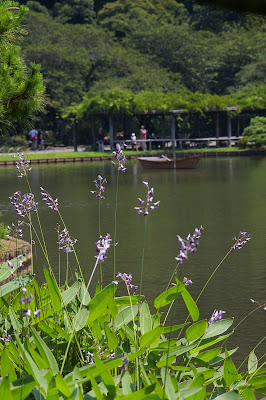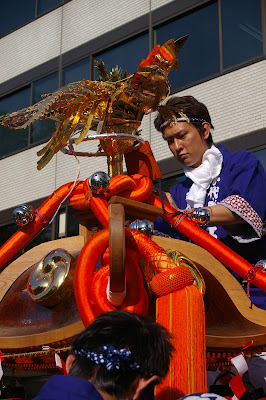As I sat under the cherry tree, which in spring had been laden with lovely blossoms, I enjoyed a delicious chocolate ice cream and the peace and tranquilty of the traditional Japanese gardens. The air was filled with the chirping of crickets and the croaking of frogs. Giant carp were poking their heads from the water, tortoises were basking in the sun and the crows were aark-aarking above. Sitting in the shade was wonderful respite from the heat and the hot sun shining from a cloudless blue sky. My damp clothes were almost acting like a coolgardie safe but not enough to really cool me down. These days I even find my camera fogs up with the humidity. I had to lick quickly before my ice cream melted all over me. With no one to take my photo, I resorted to a self timed shot to record my presence in this beautiful place....Sankeien Gardens!
In the absence of any 'alien' visitors and to prevent me from going insane with my own company, I'm back to setting daily missions. When I first arrived in Japan, I began setting small missions to help me adapt to my new and foreign life. Setting goals meant I ventured out more and more and soon became quite comfortable with, not only my own company but, the new and unknown Tokyo. I need to remind myself that in those early days I had no one to tell me how to do anything. I know it beats work but after 15 months, sometimes, it's a bit hard maintaining enthusiasm for constant sightseeing,..... hence the latest missions.
Yesterday's mission was simple: Ride to World Porter's and have lunch at my favourite Indonesian Restaurant, Sura Baya. What a tough mission! It was a bit lonely but the food was great, as was the view. As it was really too hot outside, I spent the rest of the day wandering around the air conditioned department store in search of another small backpack for everyday forays.
I'd also had another small mission to complete. (Help Nanny! I am sad, my lucky charm's broken! Can you please get the same coloured one that's blue, dark blue for me? Thank you. Can you really, really get one for me? Please. I love you nanny. Love Henry X). Heading off through Chinatown, armed with a photo of the said charm, that mission was easy. Done! Just call me 'Jenny Lost and Found in Japan' now!
Today I decided I wanted to visit Sankeien Gardens and photograph the lovely lotus flowers, not to be confused with water lilies. Last year, I photographed the lotus flowers at the large lake in Ueno but had not seen them at Sankeien Gardens. We were relatively new in Yokohama at that stage and the gardens were still unexplored. I headed off on my trusty steed, 'the bike', and passed through the tunnel under Yamate Hills and through Honmoku. It takes about 20-25 minutes, with no errors, to reach the gardens and by the time I arrived I was pretty hot. Paying my 500 yen admittance fee and walking through the gates, I realized instantly that my choice to visit the gardens was perfect.
Like a typical tourist I clicked away taking photos of the lotus flowers (hasu no hana), seed pods and plants. The roots of the lotus plant, sliced and boiled, are used in various Asian cuisines. Lotus rootlets are often pickled with rice vinegar, sugar, chili and garlic. They have a crunchy texture with a sweet-tangy flavour. The dried seed pods are a familiar addition to many floral arrangements.
On the shady side of the lake, children were fishing for yabbies or freshwater prawns. Using bamboo sticks with string and dried cuttlefish as bait, the yabbies were lured away from their safe haven under the canopy of lotus leaves. There was much excitement and merriment each time an unfortunate creature was snared.
Ladies wandered around the gardens sheltered by umbrellas and I even saw a photographer 'shooting' a young bride and husband to be. Listening to him calling out lengthy instructions to the assistants made me think I was on the set for 'Lost in Translation'!
Beautiful large, bluey-green butterflies were flitting everywhere but, unfortunately, were too active to be photographed. Beautiful lotus, crepe myrtles and plenty of critters. I spent a very pleasant few hours wandering around and then headed home.
I don't know whether I had been steamed, broiled or baked but I was cooked to perfection, medium rare I believe, by the time I arrived home! Phew!! It's common thing to say here, 'Totemo atsui desu ne!' I think the workers who I passed on my return journey had the right idea.










































